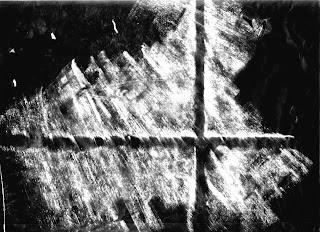I finished my series of prints and exhibited them in the gallery at Central House. I exhibited ten prints in two rows of five:
This is the blurb I attached:
This is the blurb I attached:
Variations
on two themes:
Bathroom
Crack
Kitchen
Floor (after the party) 2012
Two
plate etchings, and two plate etchings with lino print
The idea of indeterminacy and process are used to create images which include
marks that are both present and absent. Drawing on Jacques Derrida’s philosophy of Hauntology – (the present
exists only with respect to the past); the initial painted marks (made on lino)
are etched and attacked, then transferred to metal, further etched and then
printed. The resultant image holds the
absence of the original; it becomes a memory or a ghost, a negative of a positive. The two and three plate images become
palimpsests, superimposed and layered marks bearing traces of those beneath and
setting up a tension between the mark making and its absence with an illusion
of depth contrasting flatness.
The
unpredictability of the acid attack on different materials, leaves the image to
chance and together with the lengthy process taken, goes some way to remove it
from aesthetic decision making, as seen in the work of John Cage and Antoni
Tapies. This is further reinforced within
the practice of printmaking where there is an importance of craftsmanship and
skill, as proposed by Richard Sennett, and through a Zen-like adherence to
repetition necessary for skill to be perfected.
This work has developed from rubbings and marks taken from the artist's surroundings,
noticing and enlarging on elements that are usually overlooked such as cracks,
scratches, dirt and spillages. These
insignificant marks and flaws become significant items, and together it is hoped that the
resultant series may give a new description of the environment.










































